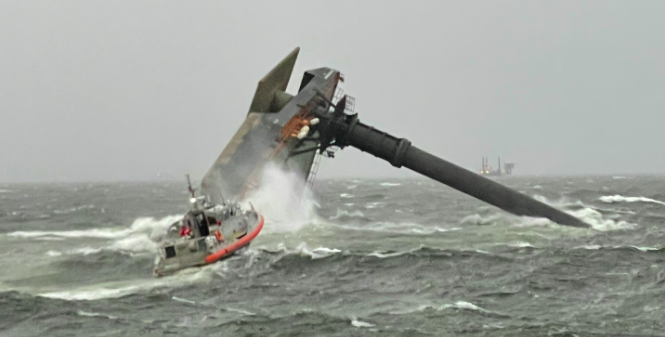Less than a month after the USCG revealed plans to refloat the ill-fated liftboat Seacor Power, the operation has become more challenging with salvage crews reporting that the wreck has rotated and that the hull has separated from the superstructure.
This is according to information by the unified command consisting of the US Coast Guard and SEACOR, during an update meeting for the family members of the crew in Houma, Wednesday. Family members were provided with information from SEACOR and the contracted Donjon-SMIT salvage team on efforts to remove the vessel and what the potential timeline for that process is expected to be.
The Seacor Power departed Port Fourchon at about 1:30 p.m. April 13, bound for the oil and gas lease area Main Pass Block 138 in the Gulf of Mexico, but capsized amid heavy weather. Six people survived and six died as a result, while seven remain missing.
[smlsubform prepend=”GET THE SAFETY4SEA IN YOUR INBOX!” showname=false emailtxt=”” emailholder=”Enter your email address” showsubmit=true submittxt=”Submit” jsthanks=false thankyou=”Thank you for subscribing to our mailing list”]
Throughout last week, contracted salvage crews have been removing obstructions from the seafloor around the partially sunken lift boat. Removal of the debris will make room for the equipment needed to raise vessel sections to the surface.
The SEACOR Power remains in the same location where it sank but has rotated, and salvors report cracking and separation of the hull from the superstructure.
The separation indicates that the structural integrity of the vessel is compromised. As a result, the vessel will have to be raised to the surface and brought to shore in separate sections,
…USCG informed.
The Donjon-SMIT salvage team is outfitting a barge with a pump system that allows it to be submerged and maneuvered under the larger sections of the vessel. Once in place, water is pumped out of the barge and it is refloated with the larger sections already on board in conjunction with assistance from a crane barge on the surface. This method preserves the structural integrity of the recovered section. Safety netting will also be placed around the openings of each section as it is raised and transported.
Removal of the largest sections is expected to be complete by the end of June, but the timeline depends on many factors including the safety of salvage crews, the weather, and any new structural changes that may occur,
…the update further informs.
SEACOR assets will remain in the area until the end of July to recover any remaining debris from the seafloor.
Meanwhile, the Coast Guard safety zone extending 1 nautical mile around the site and the Federal Aviation Administration temporary flight restriction covering a 5 nautical mile radius around the site and 2,000-foot minimum altitude will remain in place until salvage operations are complete.
The incident is under investigation by the National Transportation Safety Board and the USCG.































































